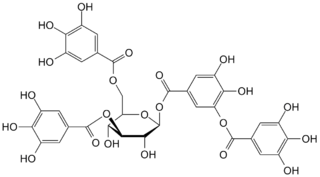
Quinine is a medication used to treat malaria and babesiosis. This includes the treatment of malaria due to Plasmodium falciparum that is resistant to chloroquine when artesunate is not available. While used for restless legs syndrome, it is not recommended for this purpose due to the risk of side effects. It can be taken by mouth or used intravenously. Malaria resistance to quinine occurs in certain areas of the world. Quinine is also the ingredient in tonic water that gives it its bitter taste.

Tannic acid is a specific form of tannin, a type of polyphenol. Its weak acidity (pKa around 6) is due to the numerous phenol groups in the structure. The chemical formula for commercial tannic acid is often given as C76H52O46, which corresponds with decagalloyl glucose, but in fact it is a mixture of polygalloyl glucoses or polygalloyl quinic acid esters with the number of galloyl moieties per molecule ranging from 2 up to 12 depending on the plant source used to extract the tannic acid. Commercial tannic acid is usually extracted from any of the following plant parts: Tara pods (Caesalpinia spinosa), gallnuts from Rhus semialata or Quercus infectoria or Sicilian Sumac leaves (Rhus coriaria).
Jesuit's Bark, also known as cinchona bark, as Peruvian Bark, and as China Bark, is a former name of the most celebrated specific remedy for all forms of malaria. It is so named because it was obtained from the bark of several species of the genus Cinchona, of the Rubiaceae family, that have been discovered at different times and are indigenous in the Western Andes of South America and were first described and introduced by Jesuit priests who did missionary work in Peru. Other terms referring to this preparation and its source were "Jesuit's Tree", "Jesuit's Powder" and "Pulvis Patrum".
Quinic acid is a cyclitol, a cyclic polyol, and a cyclohexanecarboxylic acid. It is a colorless solid that can be extracted from plant sources. Quinic acid is implicated in the perceived acidity of coffee.

Lillet, classed as an aromatised wine within EU law, is a French wine-based aperitif from Podensac. It is a blend of 85% Bordeaux region wines and 15% macerated liqueurs, mostly citrus liqueurs. The mix is then stirred in oak vats until blended. During the aging process, Lillet is handled as a Bordeaux wine.

Cinchona officinalis is a South American tree in the family Rubiaceae. It is native to wet montane forests in Colombia, Ecuador, Peru and Bolivia, between 1600–2700 meters above sea level.
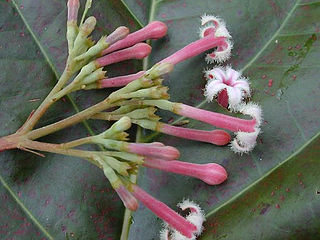
Cinchona pubescens, also known as red cinchona and quina (Quechua), is native to Central and South America. It is known as a medicinal plant for its bark's high quinine content- and has similar uses to Cinchona officinalis in the production of quinine, most famously used for treatment of malaria.

Jean-Jacques Chifflet (Chiflet) was a physician, antiquary and archaeologist from the County of Burgundy.
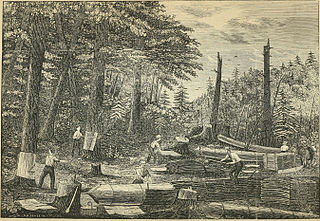
Tanbark is the bark of certain species of tree. It is traditionally used for tanning hides into leather.
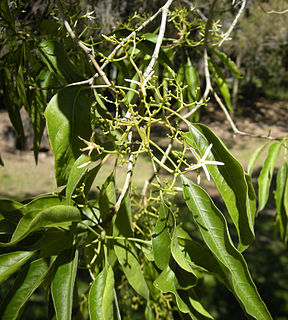
Alstonia constricta, commonly known as Quinine Bush or Bitterbark, is an endemic Australian endemic shrub or small tree of the family Apocynaceae.
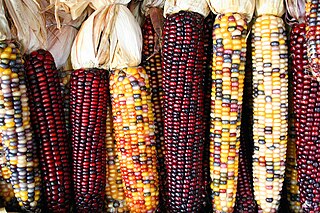
Phlobaphenes are reddish, alcohol-soluble and water-insoluble phenolic substances. They can be extracted from plants, or be the result from treatment of tannin extracts with mineral acids. The name phlobaphen come from the Greek roots φλoιὀς (phloios) meaning bark and βαφή (baphe) meaning dye.
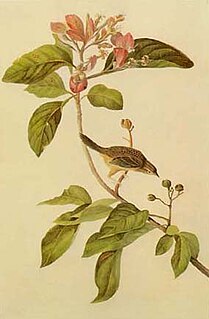
Pinckneya pubens, the Georgia bark or fevertree, is a small tree of the southern United States closely resembling the cinchona or Peruvian bark. It has pretty, large white flowers, with longitudinal stripes of rose-color. The wood is soft and unfit for use in the arts. The inner bark is extremely bitter.
An aromatised wine is a fortified wine or mistelle that has been flavoured with herbs, spices, fruit or other natural flavourings.

Charles Henry Wood was a British chemist. He was employed in the study of quinine extraction in British India, where he was a Professor of Chemistry at the Medical College, Calcutta.

William Graham McIvor was a Scottish gardener and superintendent of the Neilgherry Cinchona plantations in Ootacamund, India who was responsible for the successful introduction of cinchona plants in the Nilgiris in the 1860s.
The Schedula Romana was a pharmaceutical handbill published in 1649. Generally assumed to have been designed after the knowledge of the cinchona bark properties brought from South America by Spanish Jesuit Juan de Lugo, the Schedula Romana is considered to be an early example of an efficient antimalarial recipe. The Schedula gives instructions on proper dosages and application of the cinchona bark. The doses recommended are likely to have been established by trial and error, and they are assumed to be relied on results obtained using the various recipes proposed by Roman apothecaries.

The Therapeutice Specialis ad Febres Periodicas Perniciosas is a book published in 1712 and written by Italian physician Francesco Torti (1658–1741), professor of medicine at Modena. The book illustrates an elaborate taxonomy of fevers in order to explain which ones could be cured by the use of the cinchona bark. The Therapeutice Specialis is considered the first systematic study of the action of cinchona in different types of fever.
The Cinchona Missions (1942-1945) were a series of expeditions led by the United States to find natural sources of quinine in South America during World War II.
